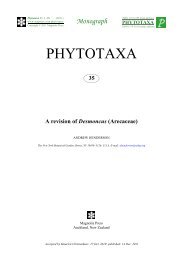Zootaxa, Taxonomy of Serpulidae (Annelida ... - Magnolia Press
Zootaxa, Taxonomy of Serpulidae (Annelida ... - Magnolia Press
Zootaxa, Taxonomy of Serpulidae (Annelida ... - Magnolia Press
Create successful ePaper yourself
Turn your PDF publications into a flip-book with our unique Google optimized e-Paper software.
Remarks. The diagnosis above is partly based on a personal communication by R. Bastida-Zavala. This is<br />
a poorly known monotypic genus with unclear affinities. According to Rzhavsky (pers. comm.), Neomicrorbis<br />
belongs to the Spirorbidae (Paralaeospirinae) because <strong>of</strong> its incomplete chaetal inversion typical for<br />
spirorbins. Reproduction is unknown, which makes placement within spirorbins difficult. Zibrowius (1972a)<br />
regards it as something intermediate between a “serpulid” and a spirorbin.<br />
Neomicrorbis azoricus Zibrowius, 1972a, Azores, St. Paul Island, West Indian Ocean.<br />
24. Neovermilia Day, 1961<br />
(Fig. 30)<br />
Type-species: Neovermilia capensis Day, 1961<br />
Number <strong>of</strong> species: 6<br />
Tube white, opaque, triangular to subcircular in cross-section, medial keel may be present. Granular overlay<br />
absent, though hyaline inner (bordering lumen) and hyaline outer layers may be present. Tabulae occasionally<br />
present. Operculum globular, s<strong>of</strong>t proximally, at most with slightly chitinized, or sclerotized, or calcified cap.<br />
Operculum absent in one species. Peduncle sub-cylindrical to triangular, wrinkled (annulated), sometimes<br />
with small distal latero-dorsal “winglets” (flattened parts <strong>of</strong> the peduncle), constriction present; inserted at<br />
base <strong>of</strong> first to fourth normal radiole. Pseudoperculum absent (but see remarks). Radioles arranged in semicircles<br />
to short spiral (1.5 whorls), up to 50 per lobe. Inter-radiolar membrane present (that is, radioles fused<br />
basally for about 1/20 th <strong>of</strong> their length). Stylodes absent. Branchial eyes not observed. Mouth palps absent. 7<br />
thoracic chaetigerous segments. Collar trilobed, tonguelets between ventral and lateral collar lobes absent.<br />
Thoracic membranes forming ventral apron across anterior abdominal segment. Collar chaetae limbate.<br />
Apomatus chaetae absent. Thoracic uncini saw-shaped with 5–6 teeth above pointed anterior fang (Fig. 30A);<br />
saw-to-rasp shaped in one species. Triangular depression absent, but rows <strong>of</strong> thoracic tori converge,<br />
completely touching each other medioventrally. Abdominal chaetae long, trumpet-shaped, smoothly bent,<br />
with hollow end bordered by two rows <strong>of</strong> pointed teeth (Fig. 30C). Abdominal uncini similar to thoracic ones,<br />
with 7 teeth above fang (Fig. 30B). Achaetous anterior abdominal zone absent. Posterior capillary chaetae and<br />
glandular pad absent.<br />
Remarks. Ten Hove (1975) tabulated the known species <strong>of</strong> Neovermilia. Later, two more species were<br />
described and attributed to this genus, N. aberrans Rullier & Amoureux, 1979 and N. anoperculata Lechapt,<br />
1992. Uncini <strong>of</strong> N. aberrans were figured with a bifid anterior peg; contrary to the description, Apomatus<br />
chaetae are present, and the number <strong>of</strong> thoracic chaetigers is higher than 7 (Zibrowius, pers. comm.), it might<br />
rather belong to Filogranella. The taxon anoperculata agrees well with the diagnosis <strong>of</strong> Neovermilia, but for<br />
the absence <strong>of</strong> an operculum and its thoracic uncini which are saw-to-rasp-shaped. One specimen <strong>of</strong> N.<br />
globula from Taronga Park checked by one <strong>of</strong> us (HAtH; Australian Museum) had a pseudoperculum in<br />
addition to the normal peduncle.<br />
1. Neovermilia anoperculata Lechapt, 1992, New Caledonia; SEM photos <strong>of</strong> chaetae in original description<br />
2. Neovermilia capensis Day, 1961, False Bay, South Africa<br />
3. Neovermilia dewae (Straughan, 1967b), Heron Island, Queensland, Australia<br />
4. Neovermilia falcigera (Roule, 1898), Cape Bojador; East Atlantic from <strong>of</strong>f Ireland to North Africa,<br />
Mediterranean; bathyal<br />
5. Neovermilia globula (Dew, 1959), Port Jackson, New South Wales, Australia<br />
6. Neovermilia sphaeropomatus (Benham, 1927), New Zealand.<br />
66 · <strong>Zootaxa</strong> 2036 © 2009 <strong>Magnolia</strong> <strong>Press</strong><br />
TEN HOVE & KUPRIYANOVA
















